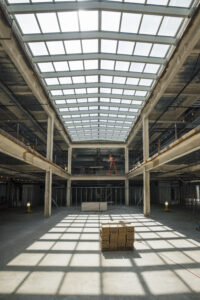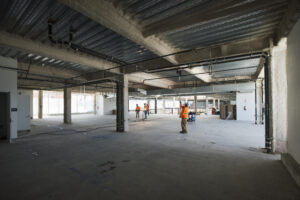Photo: The former Sears building had already been partially renovated in 2020 by developers who converted the four-story structure with plans to fill it with offices and restaurants.
By Lindsey Coulter

When devastating wildfires rendered nearly 40% of Palisades Charter High School’s campus unusable in January, administrators at the Los Angeles school faced a daunting question: how to resume in-person education for thousands of students on short notice.
While students continued their education via Zoom, school officials and project partners found a more concrete solution in the form of an unlikely structure—a 100,000-square-foot former Sears department store. The building was renovated and retrofitted in just over a month into a fully functioning temporary high school for Palisades Charter High School’s nearly 2,500 students, educators and staff members.
The fast-tracked success of the project was driven by a coordinated team of experienced partners. Led by C.W. Driver, a general contractor with a long history of K-12 construction, the project involved stakeholders including Gensler, the City of Santa Monica and the Santa Monica Fire Department. Key subcontractors included AJ Kirkwood & Associates, ProCraft Construction, ACCO, Raymond Group and Continental Painting, among others.
A Blank Canvas with Built-In Advantages
While the former department store was never intended to host classrooms, its existing infrastructure, modern upgrades and open-plan layout helped accelerate the transformation to a temporary home for education.

The building had already been partially renovated in 2020 by developers who converted the four-story structure with plans for filling it with offices and restaurants. Those plans were derailed by the Covid-19 pandemic, but the completed work provided the project team with a critical head start. Improvements that were made prior to the conversion—including seismic reinforcement, new HVAC systems, an upgraded electrical system, and code-compliant fire and life safety measures—allowed the design and construction teams to bypass long-lead procurement items and some of the more costly equipment of the project.
“The foundational attributes of the Sears building allowed the team to create a functional, safe, and surprisingly effective temporary high school environment in an exceptionally short timeframe,” said Jaime Macartney, project executive at C.W. Driver Companies.
Each floor of the building offered 20,000 to 30,000 square feet of open layout—essentially, a structural blank canvas. That flexibility proved critical. Cost- and time-effective partition walls were deployed quickly to carve out roughly 90 classrooms and various support spaces.
The steel-and-concrete structure offered a robust shell, while its adjacency to public transit and ample parking made it logistically appealing. A pedestrian tunnel connecting directly to the drop-off area was another bonus for student and parent access.
“The entire construction timeline was approximately five weeks, with crews working six days a week in swing shifts, totaling around 25 active workdays,” Macartney noted.
That kind of pace required not only expertise, but relentless commitment. According to the firm, team members relocated temporarily to stay near the site. Senior Superintendent Ray Weaver led the on-site crew with what colleagues described as “decisive leadership.”
“There were no finalized plans or permits when we started,” Macartney said. “The team had to operate at an unprecedented pace, coordinating around the clock with Gensler, subcontractors and regulatory agencies.”
Retail Roots, Educational Challenges
Despite the building’s advantages, adapting a former retail space into a place of learning required significant ingenuity and problem-solving. Chief among the challenges were determining ideal circulation and adjusting acoustics to better support learning and focus.
“The building met code for life safety features like elevators and stairwells, but the building conveyance was not designed for high-frequency, high-volume movement, such as class transitions every hour,” Macartney said.
Navigating the space proved difficult in the first weeks of occupancy, especially with several thousand students and staff members circulating simultaneously. The design team and school officials collaborated closely to refine pathways and mitigate congestion through operational tweaks.
Mitigating noise, however, was an even trickier obstacle. “The open, concrete-and-steel structure allowed sound to travel easily—so much so that someone could speak from one end of the building and be heard on the other,” Macartney explained.
To resolve this, a multi-layered acoustic strategy was implemented. Partition walls were enhanced with carpet donated by companies including Mohawk and Shaw, and acoustic wall panels were installed. Additionally, “InsulQuilt” sound blankets were suspended from the ceiling deck to the top of the walls.
Read more about the effort to quickly create a safe and stable place for students to learn, connect and continue their education — and how teams navigated supply-chain challenges — in the May/June issue of School Construction News.


